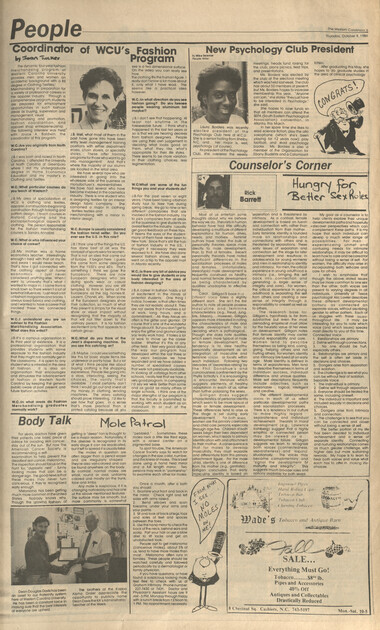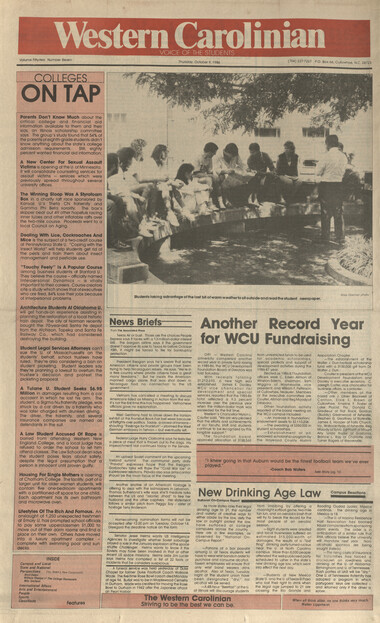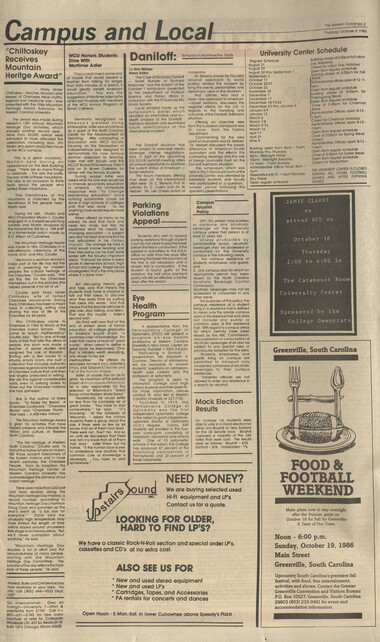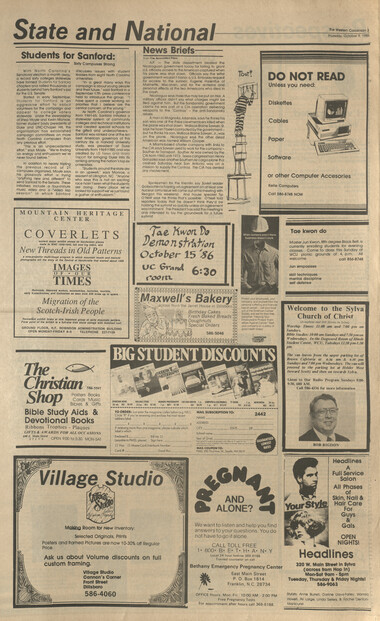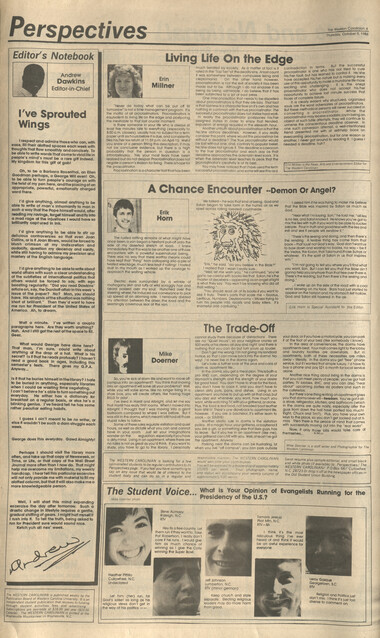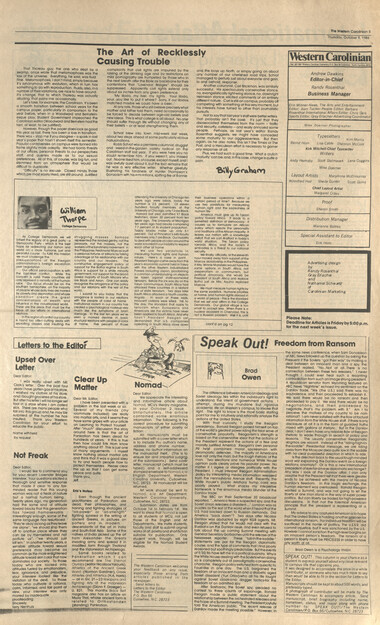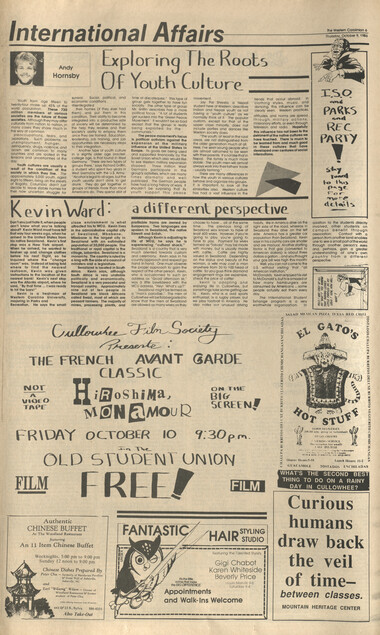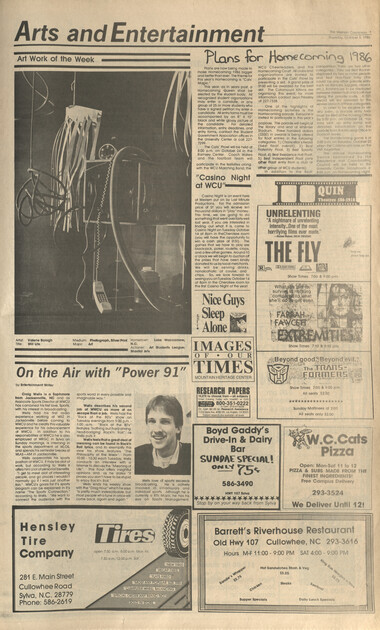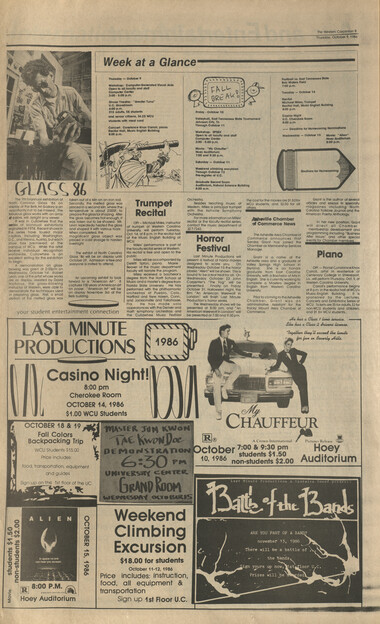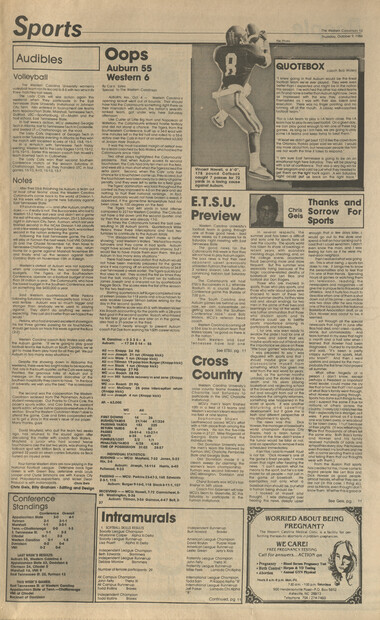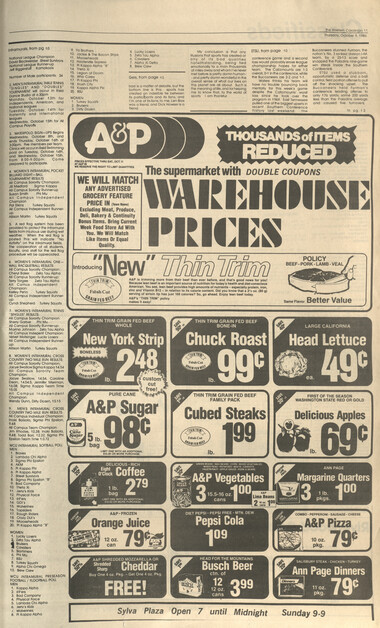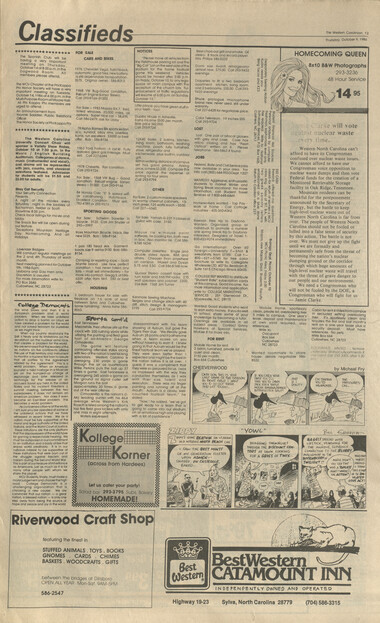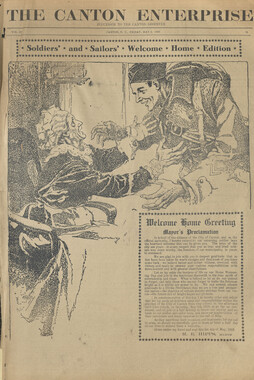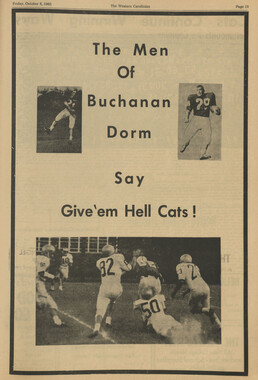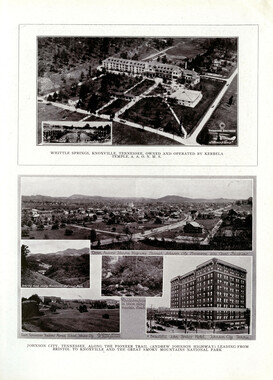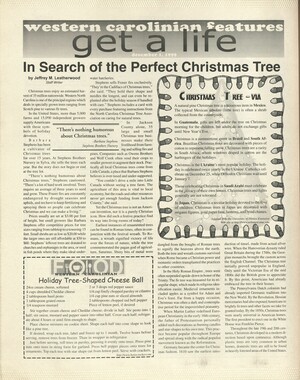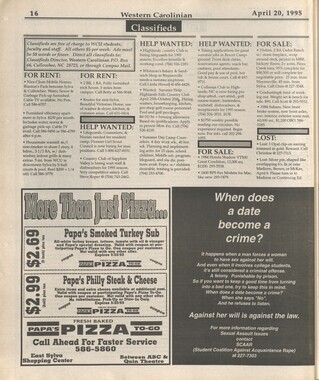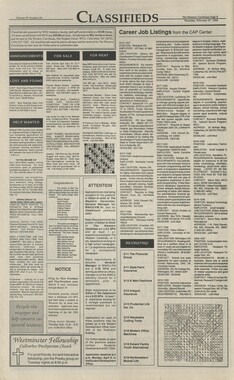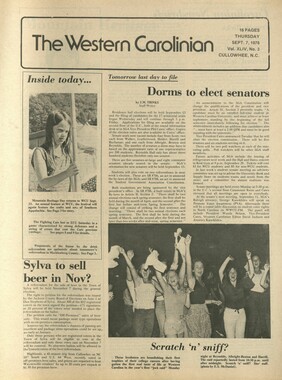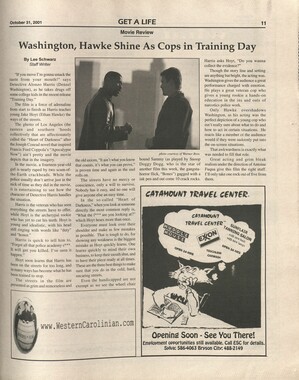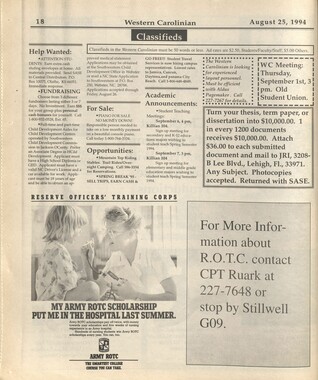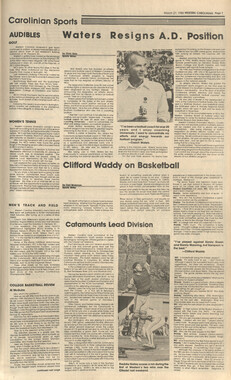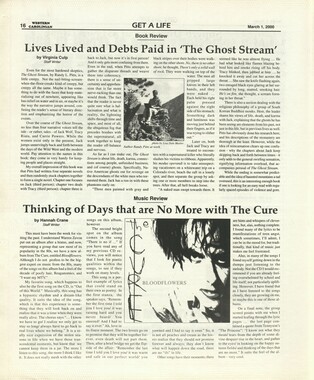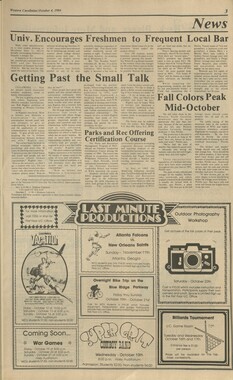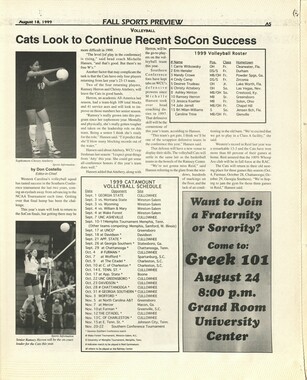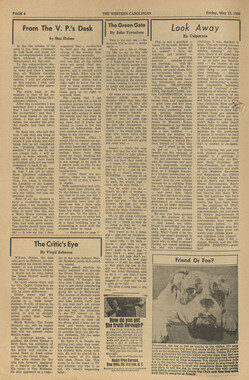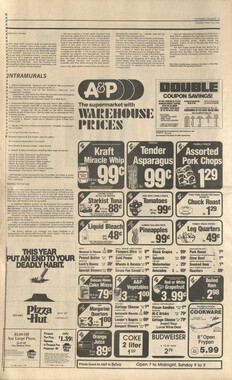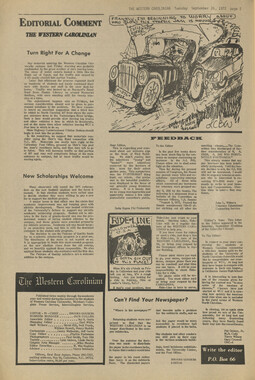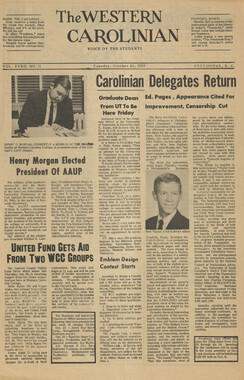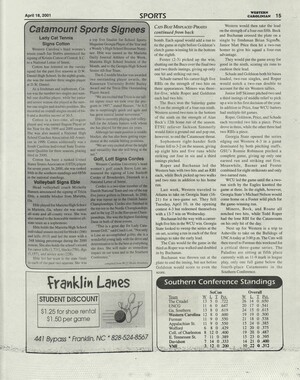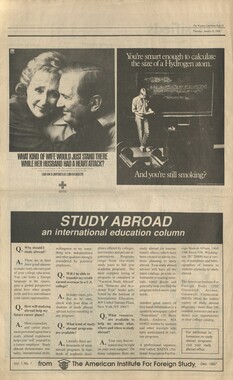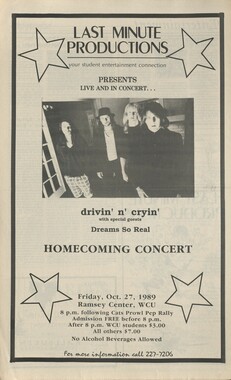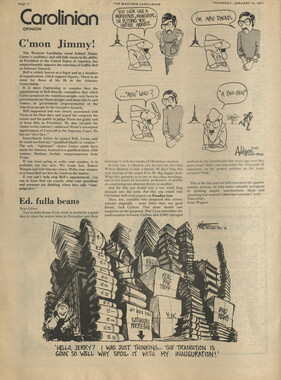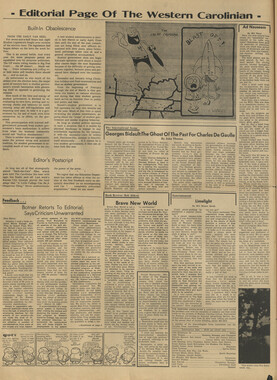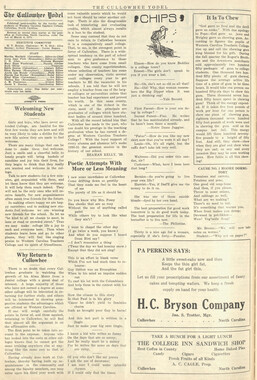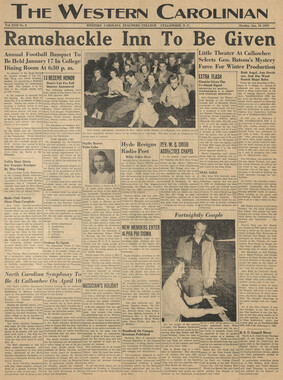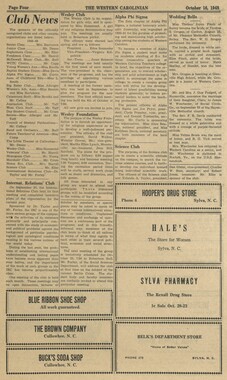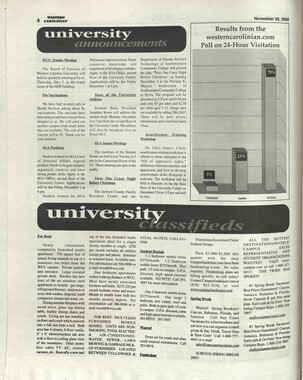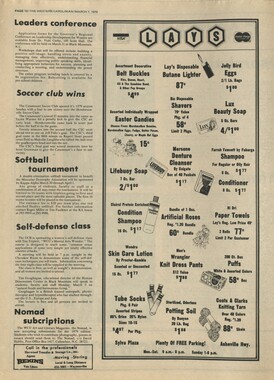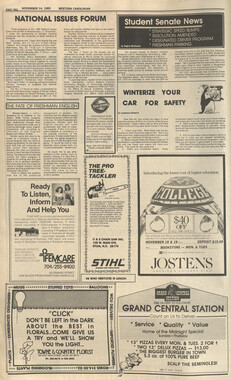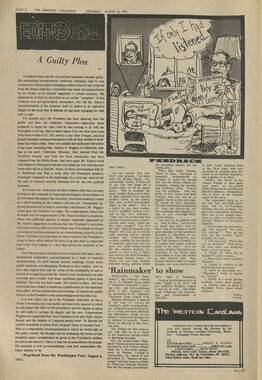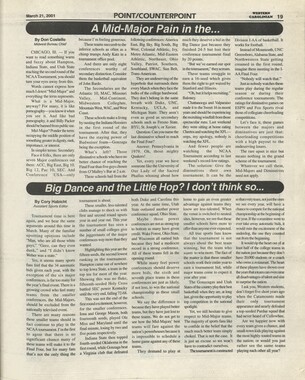Western Carolina University (20)
View all
- Canton Champion Fibre Company (2308)
- Cherokee Traditions (293)
- Civil War in Southern Appalachia (165)
- Craft Revival (1942)
- Great Smoky Mountains - A Park for America (2767)
- Highlights from Western Carolina University (430)
- Horace Kephart (941)
- Journeys Through Jackson (154)
- LGBTQIA+ Archive of Jackson County (24)
- Oral Histories of Western North Carolina (314)
- Picturing Appalachia (6772)
- Stories of Mountain Folk (413)
- Travel Western North Carolina (160)
- Western Carolina University Fine Art Museum Vitreograph Collection (129)
- Western Carolina University Herbarium (92)
- Western Carolina University: Making Memories (708)
- Western Carolina University Publications (2283)
- Western Carolina University Restricted Electronic Theses and Dissertations (146)
- Western North Carolina Regional Maps (71)
- World War II in Southern Appalachia (131)
University of North Carolina Asheville (6)
View all
- Western Carolina College (199)
- Western Carolina Teachers College (239)
- Western Carolina University (1792)
- Allanstand Cottage Industries (0)
- Appalachian National Park Association (0)
- Bennett, Kelly, 1890-1974 (0)
- Berry, Walter (0)
- Brasstown Carvers (0)
- Cain, Doreyl Ammons (0)
- Carver, George Washington, 1864?-1943 (0)
- Cathey, Joseph, 1803-1874 (0)
- Champion Fibre Company (0)
- Champion Paper and Fibre Company (0)
- Cherokee Indian Fair Association (0)
- Cherokee Language Program (0)
- Crittenden, Lorraine (0)
- Crowe, Amanda (0)
- Edmonston, Thomas Benton, 1842-1907 (0)
- Ensley, A. L. (Abraham Lincoln), 1865-1948 (0)
- Fromer, Irving Rhodes, 1913-1994 (0)
- George Butz (BFS 1907) (0)
- Goodrich, Frances Louisa (0)
- Grant, George Alexander, 1891-1964 (0)
- Heard, Marian Gladys (0)
- Kephart, Calvin, 1883-1969 (0)
- Kephart, Horace, 1862-1931 (0)
- Kephart, Laura, 1862-1954 (0)
- Laney, Gideon Thomas, 1889-1976 (0)
- Masa, George, 1881-1933 (0)
- McElhinney, William Julian, 1896-1953 (0)
- Niggli, Josephina, 1910-1983 (0)
- North Carolina Park Commission (0)
- Osborne, Kezia Stradley (0)
- Owens, Samuel Robert, 1918-1995 (0)
- Penland Weavers and Potters (0)
- Rhodes, Judy (0)
- Roberts, Vivienne (0)
- Roth, Albert, 1890-1974 (0)
- Schenck, Carl Alwin, 1868-1955 (0)
- Sherrill's Photography Studio (0)
- Smith, Edward Clark (0)
- Southern Highland Handicraft Guild (0)
- Southern Highlanders, Inc. (0)
- Stalcup, Jesse Bryson (0)
- Stearns, I. K. (0)
- Thompson, James Edward, 1880-1976 (0)
- United States. Indian Arts and Crafts Board (0)
- USFS (0)
- Vance, Zebulon Baird, 1830-1894 (0)
- Weaver, Zebulon, 1872-1948 (0)
- Western Carolina University. Mountain Heritage Center (0)
- Whitman, Walt, 1819-1892 (0)
- Wilburn, Hiram Coleman, 1880-1967 (0)
- Williams, Isadora (0)
- 1920s (57)
- 1930s (69)
- 1940s (114)
- 1950s (66)
- 1960s (314)
- 1970s (599)
- 1980s (406)
- 1990s (379)
- 2000s (195)
- 2010s (83)
- 1600s (0)
- 1700s (0)
- 1800s (0)
- 1810s (0)
- 1820s (0)
- 1830s (0)
- 1840s (0)
- 1850s (0)
- 1860s (0)
- 1870s (0)
- 1880s (0)
- 1890s (0)
- 1900s (0)
- 1910s (0)
- 2020s (0)
- Jackson County (N.C.) (2282)
- Appalachian Region, Southern (0)
- Asheville (N.C.) (0)
- Avery County (N.C.) (0)
- Blount County (Tenn.) (0)
- Buncombe County (N.C.) (0)
- Cherokee County (N.C.) (0)
- Clay County (N.C.) (0)
- Graham County (N.C.) (0)
- Great Smoky Mountains National Park (N.C. and Tenn.) (0)
- Haywood County (N.C.) (0)
- Henderson County (N.C.) (0)
- Knox County (Tenn.) (0)
- Knoxville (Tenn.) (0)
- Lake Santeetlah (N.C.) (0)
- Macon County (N.C.) (0)
- Madison County (N.C.) (0)
- McDowell County (N.C.) (0)
- Mitchell County (N.C.) (0)
- Polk County (N.C.) (0)
- Qualla Boundary (0)
- Rutherford County (N.C.) (0)
- Swain County (N.C.) (0)
- Transylvania County (N.C.) (0)
- Watauga County (N.C.) (0)
- Waynesville (N.C.) (0)
- Yancey County (N.C.) (0)
- Newsletters (510)
- Publications (documents) (1773)
- Aerial Photographs (0)
- Aerial Views (0)
- Albums (books) (0)
- Articles (0)
- Artifacts (object Genre) (0)
- Biography (general Genre) (0)
- Cards (information Artifacts) (0)
- Clippings (information Artifacts) (0)
- Crafts (art Genres) (0)
- Depictions (visual Works) (0)
- Design Drawings (0)
- Drawings (visual Works) (0)
- Envelopes (0)
- Facsimiles (reproductions) (0)
- Fiction (general Genre) (0)
- Financial Records (0)
- Fliers (printed Matter) (0)
- Glass Plate Negatives (0)
- Guidebooks (0)
- Internegatives (0)
- Interviews (0)
- Land Surveys (0)
- Letters (correspondence) (0)
- Manuscripts (documents) (0)
- Maps (documents) (0)
- Memorandums (0)
- Minutes (administrative Records) (0)
- Negatives (photographs) (0)
- Newspapers (0)
- Occupation Currency (0)
- Paintings (visual Works) (0)
- Pen And Ink Drawings (0)
- Periodicals (0)
- Personal Narratives (0)
- Photographs (0)
- Plans (maps) (0)
- Poetry (0)
- Portraits (0)
- Postcards (0)
- Programs (documents) (0)
- Questionnaires (0)
- Scrapbooks (0)
- Sheet Music (0)
- Slides (photographs) (0)
- Sound Recordings (0)
- Specimens (0)
- Speeches (documents) (0)
- Text Messages (0)
- Tintypes (photographs) (0)
- Transcripts (0)
- Video Recordings (physical Artifacts) (0)
- Vitreographs (0)
- The Reporter, Western Carolina University (510)
- WCU Students Newspapers Collection (1744)
- A.L. Ensley Collection (0)
- Appalachian Industrial School Records (0)
- Appalachian National Park Association Records (0)
- Axley-Meroney Collection (0)
- Bayard Wootten Photograph Collection (0)
- Bethel Rural Community Organization Collection (0)
- Blumer Collection (0)
- C.W. Slagle Collection (0)
- Canton Area Historical Museum (0)
- Carlos C. Campbell Collection (0)
- Cataloochee History Project (0)
- Cherokee Studies Collection (0)
- Daisy Dame Photograph Album (0)
- Daniel Boone VI Collection (0)
- Doris Ulmann Photograph Collection (0)
- Elizabeth H. Lasley Collection (0)
- Elizabeth Woolworth Szold Fleharty Collection (0)
- Frank Fry Collection (0)
- George Masa Collection (0)
- Gideon Laney Collection (0)
- Hazel Scarborough Collection (0)
- Hiram C. Wilburn Papers (0)
- Historic Photographs Collection (0)
- Horace Kephart Collection (0)
- Humbard Collection (0)
- Hunter and Weaver Families Collection (0)
- I. D. Blumenthal Collection (0)
- Isadora Williams Collection (0)
- Jesse Bryson Stalcup Collection (0)
- Jim Thompson Collection (0)
- John B. Battle Collection (0)
- John C. Campbell Folk School Records (0)
- John Parris Collection (0)
- Judaculla Rock project (0)
- Kelly Bennett Collection (0)
- Love Family Papers (0)
- Major Wiley Parris Civil War Letters (0)
- Map Collection (0)
- McFee-Misemer Civil War Letters (0)
- Mountain Heritage Center Collection (0)
- Norburn - Robertson - Thomson Families Collection (0)
- Pauline Hood Collection (0)
- Pre-Guild Collection (0)
- Qualla Arts and Crafts Mutual Collection (0)
- R.A. Romanes Collection (0)
- Rosser H. Taylor Collection (0)
- Samuel Robert Owens Collection (0)
- Sara Madison Collection (0)
- Sherrill Studio Photo Collection (0)
- Smoky Mountains Hiking Club Collection (0)
- Stories of Mountain Folk - Radio Programs (0)
- Venoy and Elizabeth Reed Collection (0)
- WCU Gender and Sexuality Oral History Project (0)
- WCU Mountain Heritage Center Oral Histories (0)
- WCU Oral History Collection - Mountain People, Mountain Lives (0)
- Western North Carolina Tomorrow Black Oral History Project (0)
- William Williams Stringfield Collection (0)
- Zebulon Weaver Collection (0)
- College student newspapers and periodicals (1769)
- African Americans (0)
- Appalachian Trail (0)
- Artisans (0)
- Cherokee art (0)
- Cherokee artists -- North Carolina (0)
- Cherokee language (0)
- Cherokee pottery (0)
- Cherokee women (0)
- Church buildings (0)
- Civilian Conservation Corps (U.S.) (0)
- Dams (0)
- Dance (0)
- Education (0)
- Floods (0)
- Folk music (0)
- Forced removal, 1813-1903 (0)
- Forest conservation (0)
- Forests and forestry (0)
- Gender nonconformity (0)
- Great Smoky Mountains National Park (N.C. and Tenn.) (0)
- Hunting (0)
- Landscape photography (0)
- Logging (0)
- Maps (0)
- Mines and mineral resources (0)
- North Carolina -- Maps (0)
- Paper industry (0)
- Postcards (0)
- Pottery (0)
- Railroad trains (0)
- Rural electrification -- North Carolina, Western (0)
- School integration -- Southern States (0)
- Segregation -- North Carolina, Western (0)
- Slavery (0)
- Sports (0)
- Storytelling (0)
- Waterfalls -- Great Smoky Mountains (N.C. and Tenn.) (0)
- Weaving -- Appalachian Region, Southern (0)
- Wood-carving -- Appalachian Region, Southern (0)
- World War, 1939-1945 (0)
- Text (2283)
- MovingImage (0)
- Sound (0)
- StillImage (0)
Western Carolinian Volume 52 Number 11, October 9, 1986
Item
Item’s are ‘child’ level descriptions to ‘parent’ objects, (e.g. one page of a whole book).
-
-
People The Western Carolinian 9 Thursday, October 9, 1986 Coordinator of WCU's Fashion Program The dynamic four-year fashion merchandsing program at Western Carolina University provides men and women an academic background with a BS degree in Clothing/Textiles/ Merchandising in preparation for a variety of professional careers in the apparel industry. Through a comprehensive program,students are prepared for employment opportunities in such fashion areas as buying, supervision and management, visual merchandising and promotion, fashion coordiantion, and apparel shop entrepreneurship. The following interview was held with Joyce A. Baldwin, the coordinator of this program. W.C.:Are you originally from North Carolina? J.B.J was born and raised in North Carolina. I attended the University of North Carolina at Greenboro where I did my undergraduate degree in Home Economics Education and my master's in Clothing and Textiles. W.C.:What particular courses do you teach at Western? J.B.:My area of specialization at WCU is clothing and textiles, apparel construction-beginning construction through tailoring and pattern design. I teach courses in Historic Costume and the sociopsychological aspects of clothing. The person responsible for the fashion merchandising courses is Sandra Annabel. W.C.:What or who Influenced your choice of career? J.B.:My mother was a home economics teacher. Interestingly enough I lived with that all my life and swore I would never teach. That's how I got connected with the clothing aspect of home economics. I just never considered anything else. When I went to university that's what I wanted to major in. I came from a small town so there weren't a lot of external influences. I just read a lot of fashion magazinesand books. I always loved fabrics and clothing, and I wanted to have a career that involved these two connected things. W.C.:I understand you are an advisor to the Fashion Merchandising Association. What does this entail? J.B.:lt's a campus organization in its third year of existence. It is a professional organization that provides students with some exposure to the fashion industry that they might not normally get in the classrooms. It is open to any student who is intrested in the area of fashion. It is also an organization that encourages and stimulates the advancement of fashion in Western North Carolina by keeping the general public aware of past, present, and future fashion activities. W.C.:ln what areas do Fashion Merchandising graduates normally work? J.B: Well, what most of them in the past have gone into have been entry level management training positions with either department stores, chain storers, or speciality stores. These offer training programs for those who want to go into management. And that's where the majority of our alumni are located in the retail area. We have several now who are interested in going into the wholesale side of the business as manufacturer's representatives. We have had several who have become involved in the cosmetics industry. There is one student who is designing textiles for an interior design fabric company. She combined a major in clothing , textiles textiles and merchandising with a minor in interior design. W.C.:Europe is usualy considered the fashion trend setter. Do you ever see the U.S. in this role? J.B.:I think one of the things the U.S. has done best of all was the concept of sports wear for wo men. That is not an idea that came out of Europe. It began here. I guess this came from some designers from the 1930's and 40's. That's something I think we gave Ihe Europeans. There are now European designers who are doing sports wear or casual clothing. However, you are still tempted to think in terms of the Europeans as the big names-St. Laurent, Chanel, etc. When some of the European designers show their collection, so much of what they present is simply for the visual show or visual impact without recognizing that the majority of that will not filter down to the ordinary person. It is for fashion excitement only that appeals to a certain group. W.C.:What do you think of the Jean's dispensing machine. Do you see this catching on? J.B.:Maybe. I could see something like this for basic staple items like underwear or pantyhose. Butalot of what I think people like about buying clothing is the shopping experience. People like going into a store, interacting, seeing the choices, the vanity that's available. I most certainly don't think I would go out and invest all ,my money in clothing vending machines. The video catalog should prove interesting. I'd like to see how that goes. In a sense that's more practical than a printed catalog because all you see is a two aimensional surface. On the video you can really see how the clothing fits the human figure. I really don't know a lot more about it, only what I have read. This seems like a practical idea however. W.C.:ln what direction do you see fashion going? Do you foresee people wearing aluminum toll maybe!? J.B :l don't see that happening. At least not anytime in the foreseeable future. I think what's happened in the last ten years or so is that we are hearing decrees from fashion designers. People are using their own judgement in deciding what looks good on them, what they like, what's appropriate for their life styles. There seems to be more variation in their clothing choices, less regimentation. W.C:What are some of the fun things you and your students do? J.B.:For the past seven or eight years, I have been taking afashion study tour to New York during spring break. We go to nine or ten different companies that are involved in the fashion industry. I try to pick companies from all areas of the business to give students an overall feel forthe industry. I usually get good feedback on these trips. It" opens the eyes of the student- many of them have never been to New York. Since that's still the hub of fashion industry in the U.S., I thought it necessary they were exposed to it. We have also done several fashion shows, and we went on a trip to the apparel mart in Atlanta recently. W.C.:ls there any bit of advice you would like to give students or any body interested in the area of fashion designing? J.B.A career in fashion holds a lot of excitement in the minds of potential students. One thing I notice, however, is that often times they are not realistic about it. They are not aware that it involves a lot of work, long hours, and a commitment. All they focus on often is the glitter and glamor. Of course that's one of the wonderful things about it. Butyou don't getto enjoy the glitter and glamor unless yoy really work hard. It takes a lot of work to move up the career ladder. Whether it's this or any other field. I feel very good about the way our program has developed within the last three or four years because we have expanded and we have added a number of specialized courses that were not previously available. In looking at catalogs from other schools, I really feel that we have a very good program. In comparing I'd say we were better than some and as good as many others at larger schools. I think one of the major strengths of our program is that the faculty is committed to working with each student as an individual in or out of the classroom. Body Talk Mole fo 4<-<=>, For years, doctors have given their patients one basic piece of advice for avoiding skin cancer: stay out of the sun. But now The American Cancer Society is recommending a self- examination to help prevent the deadliest skin cancer, melanoma. The inspection should focus on the hunt for "dyplastic nevi" - funny looking moles that can be a danger sign. The good news is that these moles may never turn cancerous, if they're recognized early enough. Melanoma has been getting much more common in the United States. Nobody knows why, though the growing fashion of getting a "deep" tan is thought to be a major reason. Fortunately, if the disease is recognized in its early stage it can be eradicated, but if left to spread it is usually fatal. The moles in question are often bigger than a pencil eraser and are irregularly shaped. They're also vari-colored and can be found anywhere on the body. By contrast, normal moles are small, round or oval, uniformly colored and mostly on the trunk, face and limbs. Any mole is suspicious, if it is changing noticeablyand has one of the above mentioned features The surface may be smooth, but more commonly is somewhat Dean Douglas Davis has been an asset to our Fraternity system here at Western Carolina University. He has been a constant force in mak,ng sure that the best interests of everyone are upheld. The brothers of the Kappa Alpha Order appreciate the opportunity to publicly name Dean Davis the KA's Administrator/ Teacher of the Week. "pebbled." Sometimes these moles look a little like fried eggs, with a raised center on a pigmented base. To spot trouble, The American Cancer Society says to watch for changes in the size, color, number, and thickness of moles. Thisisbest done using a hand held mirror and a full length mirror. Two persons may work in "partnership" to examine each other for moles. Once a month, after a bath you should: 1. Examine your front and back in the mirror. Check right and left sides with arms raised. 2. Bend elbows and scan forearms, under your arms and your palms. 3. Sit and look at back of legs, tops and soles of feet and spaces between the toes. 4. Use the hand mirror to check the back of the neck, behind ears and scalp. Part your hair or use a blow drier to lift locks and get an unobstucted look. People apt to get melanoma (cancerous moles), about 5% of us, tend to have more moles than most. Melanoma often runs in families. These people should be watched carefully and followed periodically by a dermatologist or family physician. If you have questions, or have found a suspicious looking mole, feel free to check with us at Graham Infirmary. Phone number: 227-7430 or 7431. Doctor and Physician's Assistant hours are 9 AM - 5 PM, Monday through Friday with a lunch breakfrom 12 Noon to 1 PM. No appointment necessary. By Mike Doerner People Writer New Psychology Club President Laura Borders was recently elected president of the Psychology Club here at W.C.U. She is a senior hailing from Shelby, N.C. and her major is, well, psychology (of course). As president of the Psychology Club, she oversees the weekly meetings; heads fund raising for the club; plans picnics, field trips, and presentations. Ms. Borders was elected by the club at the electoral meeting which was held last week. The club has about 50 members at present, but Ms. Borders hopes to increase membership this year. "Anyone can join," she states "theyjust have to be interested in Psychology," she said. She hopes to raise funds so that all members can attend the SEPA (South Eastern Psychological Association) convention, in Atlanta, this March. In her spare time she likes to read science fiction; play the alto saxophone (which she's been playing for 12 years now); play football; and read psychology books. Ms. Borders is also a member of the Organization for Ebony Students and a Catamount Kitten. After graduating this May, she hopes to do graduate studies in the area of clinical psychology. Counselor's Corner Rick Barrett y—4J 'Be-Ucc Softies Most of us entertain some thoughts about why we behave the way we do. Theorists in human behavior have had little difficulty developing a multitude of different explanations for human drives, needs, and motives. Feminist authors have noted the bulk of personality theories speak more directly to male development, than to that of females. Recent personality theorists have noted significant differences in the socialization processes of males and females. Unfortunately, stereotypic! male development is frequently construed as healthy and normal female development as being characterized by qualities unadaptive to effective living. Carol Gilligan'S book In a Different Voice takes a slightly different slant. She isn't the first author to note all people possess masculine and feminine characteristics (e.g., Freud, Jung, Erik Erikson). However, Gilligan appears more interested in noting the characteristics of male and female development, than in deciding which is pathological. Though she does note qualities which seem more typical of male or female development, her tendency is to view healthy personality development as an integration of masculine and feminine voices or facets within each individual. Following two decades of 'awareness raising' by the Phil Donahue's and conciousness confinement by the Phyllis Schlafly's, it is encouraging ,o encounter literature which suggests elements of healthy adaptation in each of us, rather than further polarizing the sexes. Gilligan does suggest characteristics of personal identity which seem to be more typical of male or female development. These differences tend to arise as the stage is set during early development. For both sexes, women are the primary caretakers and child care persons, especially through age five. Children of both sexes begin their lives dependent on women, which leads to primary identification with and attachment to their mother. A consequence is that for males to develop masculinity, they must separate and differentiate from this primary attachment figure. For the male child, identity is one of difference from his mother (e.g., genitalia). Gilligan concludes that early masculine identity is based on 'seperation and is threatened by intimacy. As a contrast, female development is based on fusion and connection with, rather than individuation from their mother. Early feminine identity is founded more on relationships and connections with others and is theatened by separations. These early issues of separation and connection set the stage for later development and resurface in adolescence for young womena and men in relationship to identity and intimacy. For men, the critical experience in young adulthood is intimacy (i.e., bringing the self back into connection and generating a larger sense of integrity and care). For women, the critical experience in young adulthood is separating the self from others and creating a new sense of integrity through a responsibitlity to oneself as well as to others. The research base for Gilligan's hypothesis is far from substantive but even the most demading empiriscist must allow for the heuristic value of her views on development. Gilligan notes that female identity may center around responsibility and care. Women tend to describe themselves as being kind, caring, giving, helping others and not hurting others. For women, identity and intimacy are fused at an early age. Male identity is defined in terms of separateness. Men tend to describe themselves in terms of individual success, individual difference, and unique qualities. Male self descriptions frequently include adjectives, such as reasonable , logical, intelligent and creative. The different developmental voices in each of us reflect particular developmental paths and socialization processes. There is a tendency in our culture to more highly regard separateness and individual achievement. Theorists in moral development (e.g., Lawrence Kohlberg) suggest that a highly empthic or connected person may be viewed as a developmental failure. Gilligan suggests we learn to recognize both voices (connectedness, separateness) and respond situationally The voices may become complimentary and "signal the development bf maturity and integrity". This suggests much broader roles and options available for both sexes. My goal as a counselor is to help clients explore their unique develpmental pathsand hopefully f discover perspectives which can complement these paths. It is my hope that each individual can develp a much wider range of possibilities. For men experienceing unmet and confusing needs for intimate relationships, it may be difficult to learn how to care and be cared for without losing a sense of self. For women, the difficulty may arise in incorporating both self-care and care for others. I wish to emphasize that though the above stated issues may be more common to one sex than the other, both voices are present to varying degrees in all individuals. University of Texas psychologist Alic Lawler describes these different develpmental patterns as connected an separate voices, without ascribing gender to either pattern. Each of us stuggles with these issues' throughout life. it may be interesting for you to note which voice (and which issues) speaks most directly to you at this time. Connected Voice 1. Relationships are primary. 2. Define self through connections. 3. No one should be hurt, especially others. 4. Relationships are primary and the self is often set aside in decisions and choices. 5. Dangers arise from separation and isolation. 6. The challenge is to see what you can be without fear of isolation. Separate Voice 1. The individual is primary. 2. Define self through separation. 3. Everyone should be treated the same, including oneself. 4. The individual is important and included equally in decisions and choices. 5. Dangers arise from intimacy and connection. 6. The challenge is to see that you can be connected and closer without losing a sense of self. The better portion of my life has been devoted to individual achievement and a sense of separate identity. Connecting and nurturing relationships comes as much greater challenge, with higher risks but more sustaining rewards. My hope is to learn to hear both voices and value what each has to offer in making life> choices. iA, JiiT/ %*■■■ A ;•'' V'*- Imported I'ii c\ Hand R<il!cu ( .{'a, Tobacco liar Tobaccv ( luh ( hening fohaeco Jji/ ClDC $ Tobacco and Antique Barn J^ SALE... Everything Must Go! Tobacco $800 lb. Pipes and Accessories 40% Off Antiques and Collectable^ Drastically Reduced 8 Chestnut Sq. Cashiers, N.C. 743-5197 Mon.-Sat. 10-5
Object
Object’s are ‘parent’ level descriptions to ‘children’ items, (e.g. a book with pages).
-
The Western Carolinian is Western Carolina University's student-run newspaper. The paper was published as the Cullowhee Yodel from 1924 to 1931 before changing its name to The Western Carolinian in 1933.
-
